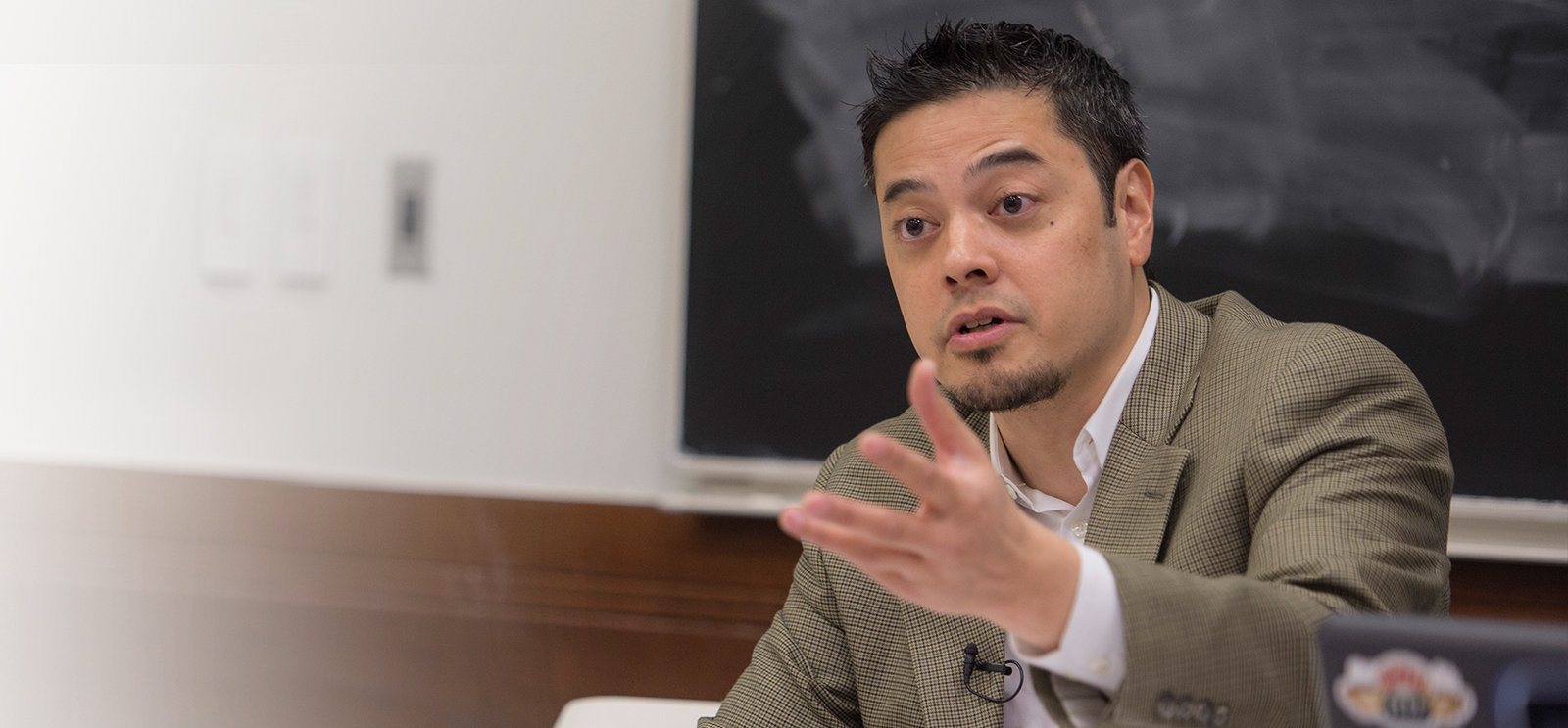
Sports are a window onto American history, says historian Matthew Briones. (Photography by Robert Kozloff)
Historian Matthew Briones sees connections between race, sports, and history.
As a child growing up in Brookline, Massachusetts—the first American-born son of Filipino immigrants—Matthew Briones was obsessed with baseball. He spent countless hours in his small backyard, throwing a tennis ball against the house and wrecking the lawn.
One afternoon his mother “gave in and joined me on my own Field of Dreams,” Briones told a group of alumni during a Harper Lecture in Philadelphia last year. His mother clearly had no understanding of the game (as Briones recalls, she challenged him to play “one on one”) but she compensated with trash talking: “Your arm is as weak as a wet noodle.”
Briones, an associate professor of history, usually shares this anecdote with his Baseball and American Culture class. And while it’s an immigrant’s story—playing a quintessentially American game with a mother who didn’t really know how—it resonates with his students. The sport “is a deeply familial, deeply felt experience,” Briones says. At the same time, he considers baseball “a remarkably appropriate and useful lens for understanding and teaching American history.” The game gets students in the door, but the course “becomes about race, gender, sexuality, and class. They’re talking about baseball in a way that hopefully they haven’t talked about it before.”
As an undergraduate at Harvard, Briones majored in English, focusing on African American literature. Being Asian American didn’t make him feel like an outsider to the discipline, he says: “It’s never been an authenticity question for me.” His mentors included Cornel West (in 2011 Briones published the essay “Why I Would Take a Bullet for Cornel West”) and Werner Sollors, a German who has “dedicated his life to Afro Am,” Briones says.
In graduate school, also at Harvard, Briones turned to history, looking at race in the United States beyond black and white. His first book, Jim and Jap Crow: A Cultural History of 1940s Interracial America (Princeton University Press, 2012) focused on the intersection of Asian American and African American culture. (An editor at the press chose the inflammatory title, based on one of the chapter titles; the original manuscript was called An American Type: The Kikuchi Diaries, 1941–1988.)
The diaries of Charles Kikuchi, EX’45, a Japanese American intellectual incarcerated during World War II, were Briones’s primary sources. Kikuchi wrote almost daily for 47 years, beginning with the bombing of Pearl Harbor. Before the attack, Briones points out in the book, some African Americans had felt solidarity with Japan, supposedly “the champion of the darker races.”
For Jim and Jap Crow, Briones looked at “a 10-year slice,” he says, totaling 20,000 pages. “It was a historian’s dream.” Kikuchi’s diaries reveal shared experiences in the postwar period among minority groups, and the growing interracial alliances that quietly shaped American culture. After studying social work in California and New York, he came to UChicago to continue his graduate education (he used an office in the Social Science Research Building that is directly above Briones’s own). Kikuchi lived on the South Side, where he forged close connections with his neighbors and came to believe that equality for African Americans would make possible inclusion for other racial and ethnic groups. Later, as a psychiatric social worker for the Veteran’s Administration, Kikuchi worked tirelessly on behalf of African American veterans of the Vietnam War.
Briones has two book projects in the works now. The first, with the working title “The Devil’s Elbow,” takes its name from a spot in the Louisiana bayou where a band of Filipino men allegedly settled in 1763, intermarrying with Native Americans, Mexicans, and Creoles. The truth of the narrative is in dispute. But Briones is “not so much interested in whether it’s true, as in the debate,” he says.
One chapter of the book explores the interaction of Vietnamese and African Americans during hurricanes Katrina and Rita. Another looks at the Southeast Asian diaspora in general. In the United States, East Asians are considered “a model minority,” whereas Southeast Asians are not, Briones says: “Vietnamese, Filipinos, Cambodians are racialized in the way that African Americans and Latinos are.”
His second project—in the very early stages and as yet unnamed—focuses on Chicago, race, and sports. With the exception of baseball and boxing, sports are generally not taken seriously as a historical topic, Briones says: “I want to help make it serious.” He hopes to find a Chicago family involved in sports, preferably from the South Side, to use as a lens on larger historic events—as Kikuchi served as a lens for Jim and Jap Crow. “I like these collective biographies,” says Briones. “A family story, a Chicago story.”
Briones, who came to UChicago in 2009, received a Llewellyn John and Harriet Manchester Quantrell Award for Excellence in Undergraduate Teaching last spring. In addition to his baseball course, his classes include History of Asians in America; Is American History Dead? An Intro to American Studies; Introduction to Asian/Pacific Islander American History; and Interracial America.
In both his research and his teaching, Briones seeks to complicate the usual black-and-white narrative of race in this country. “What about blacks and Asians?” he says. “It’s important to remember those interracial alliances. It tells a different story.”
